The Portland Bureau of Transportation has installed a new bikeway on SE Morrison between Grand and 11th (about one-third of a mile). It’s part of their SE Morrison Configuration Project that we shared details about back in August.
I rolled over to take a closer look at it yesterday.
Just for context, let’s remember that prior to this project, this segment of SE Morrison (like a lot of commercial streets in Portland) didn’t have any dedicated cycling space at all. It was six lanes of traffic. They all pointed west (towards downtown), except for one strange and unneccessary lane than went east. PBOT got rid of that eastbound lane and used the space to create the bike-only lane. The lane adjacent to the new bikeway is now bus-only during peak hours and auto parking off-peak. (See PBOT’s before-and-after graphic here.)
The new bikeway is nice. It’s relatively wide at about six feet, plus a two-foot wide buffer that’s filled with tightly-spaced plastic wands. PBOT has added green bikeway coloring to the intersections at SE 7th and Grand. It’s nice to have low-stress cycling space on this destination-filled corridor. And not having cars curbside will also vastly improve the sidewalk on Morrison, which has several outdoor cafés and bars.
Here are a few more specific observations:
➤ On several blocks, the auto parking goes very close to the intersection. This is not good for safety because it inhibits sight lines. I also noticed that people driving across Morrison like to peek out to see oncoming auto traffic — which means they roll into the bikeway.
➤ Several of these blocks are on a downhill, so bicycling speeds might be higher than usual. (making sightlines and intersection designs that much more important).
Advertisement
➤ There’s a TriMet bus stop at 10th (or is it 11th) where the bus operator will have to swing over, into the bikeway, to service the stop. PBOT removed a few plastic wands to facilitate this; but it’s a shame we can’t have a standard design for a floating bus stop to preserve the biking space and make the operator’s job easier.
➤ I was happy to see how tightly placed the wands are. If they remain standing, they should be enough to deter illegal parking in the bikeway. On that note, PBOT has posted these flyers on every block to help remind people how to park:
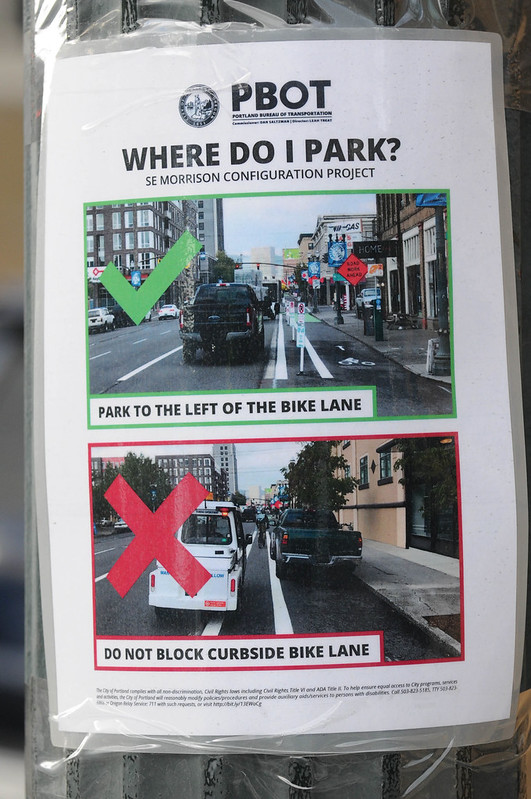
➤ The striping design at Grand is really strange and I’m not a big fan. In order to facilitate a high volume of auto users turning right (north), PBOT has opted to encourage bicycle users to merge to the left prior to the intersection (so as to avoid being in the right-hook danger zone). This is a standard design for standard (unprotected) bike lanes without bike boxes; but I don’t think I’ve seen this used in this situation before. Here, the green-painted bikeway stops and a green stripe, followed by a sharrow symbol and another green stripe are meant as breadcrumbs to help bicycle users make the merge to the left. Then there’s a bike box where you can wait during the red signal phase, prior to squiggling your way to the existing bikeways that will eventually lead you onto the Morrison Bridge (more on that later).
I get the idea PBOT had, but the markings are confusing. Perhaps we’ll all get used to them, but it would be nice if they were more consistent all over town. Worth noting that what’s on the ground today is much different than what was in the striping plans on the PBOT website. I’ve inquired about that discrepancy and will update when I hear back.
Making matters worse, only a minority of auto users seemed to know how to position themselves without encroaching on the bikeway. And I noticed a much lower rate of bike box compliance here than at other bike boxes. Perhaps we need a “$260 Fine for Violation” sign under the “Stop Here on Red” sign. Check the images below to see what I mean:
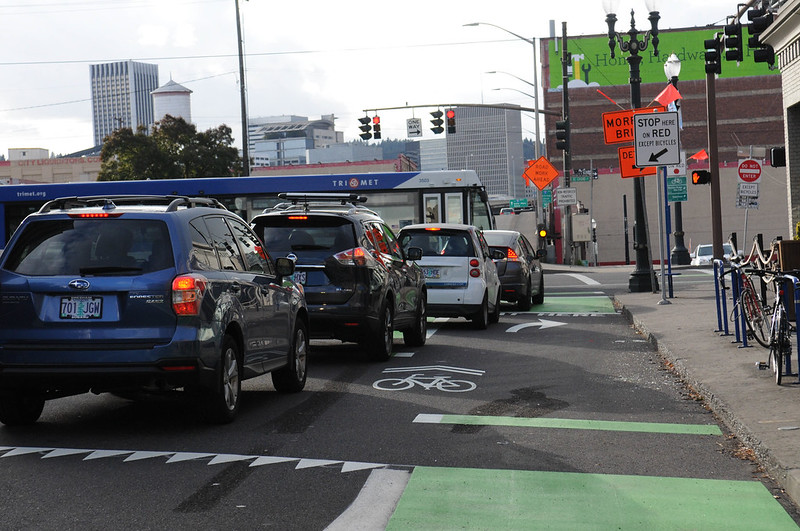
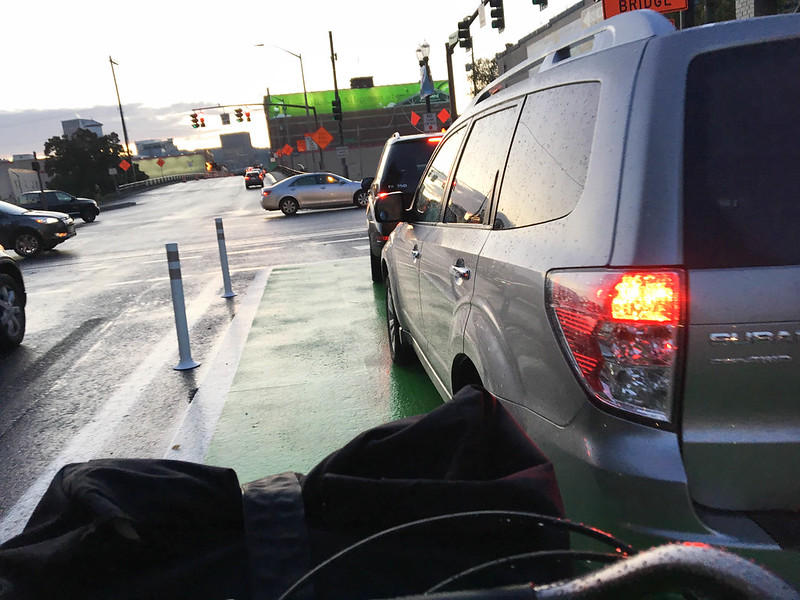
➤ This new bikeway is nice, but it would be great if it actually connected directly to the Morrison Bridge. At Grand, bicycle users are treated like a second class citizen by being shuffled across Martin Luther King Jr. Blvd, then onto a shared street under the viaduct, then onto a skinny bike lane, then onto an uphill path. Once finally on the bridge, the path forces bicycle riders away from downtown and onto Naito Parkway. Meanwhile, auto users can go straight from Morrison and directly onto the bridge and into downtown.
Look at the image below (end of bikeway at Grand) and imagine if the bikeway continued straight onto the bridge and into downtown (just like the grown-ups in the cars get to do)!
With such a disparity in access where it matters most, is it any wonder why so many Portlanders still choose to drive cars instead of ride?
Have you ridden this yet? If so, what are your impressions?
— Jonathan Maus: (503) 706-8804, @jonathan_maus on Twitter and jonathan@bikeportland.org
Never miss a story. Sign-up for the daily BP Headlines email.
BikePortland needs your support.


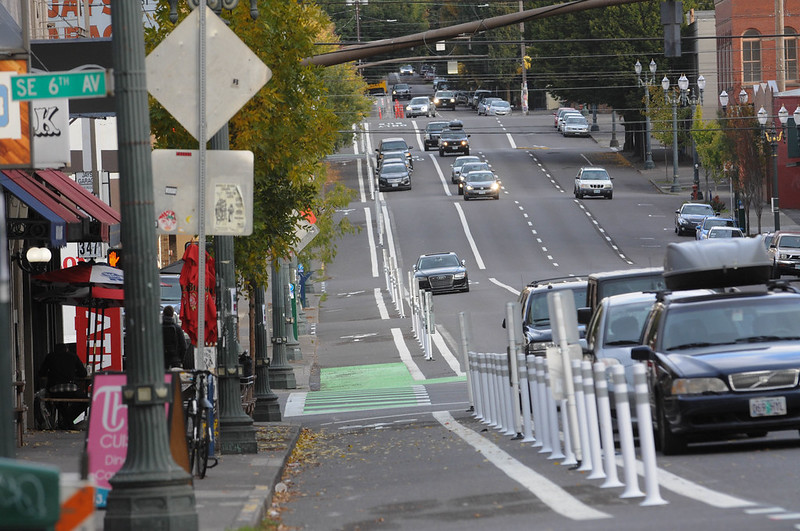

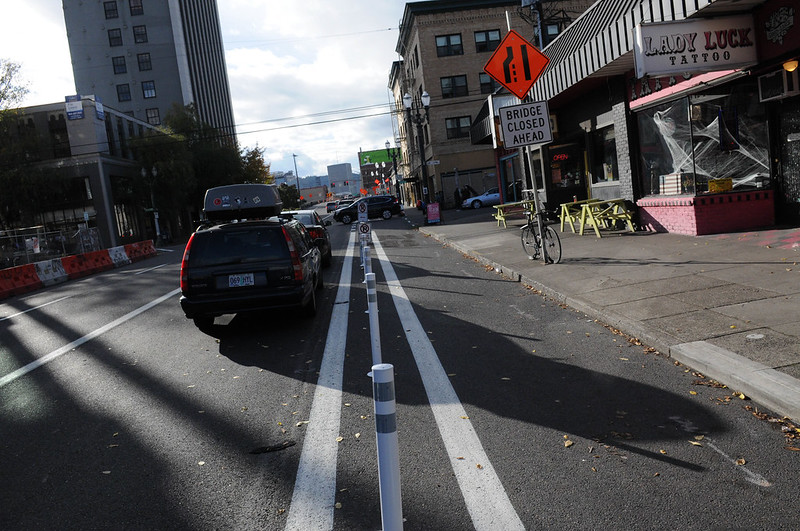
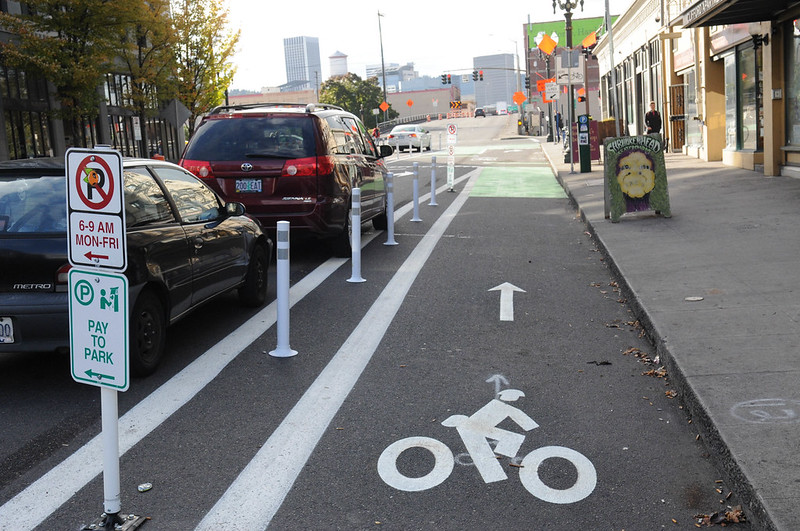
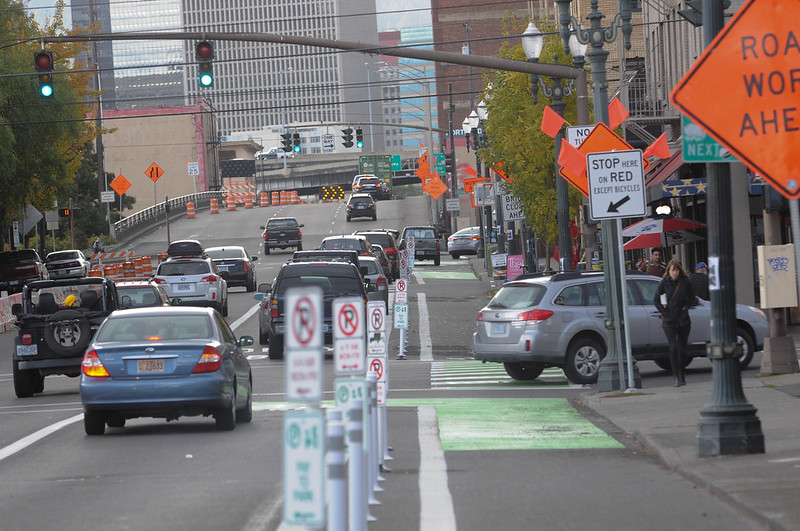
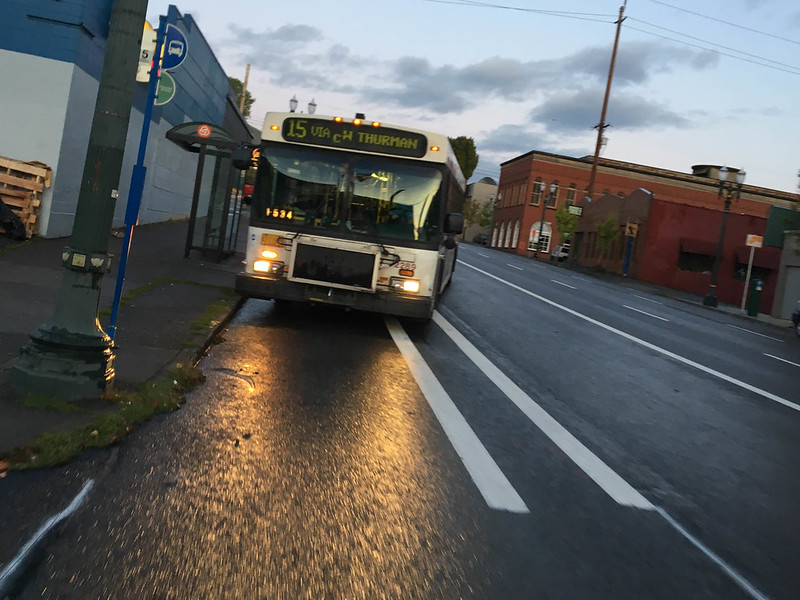
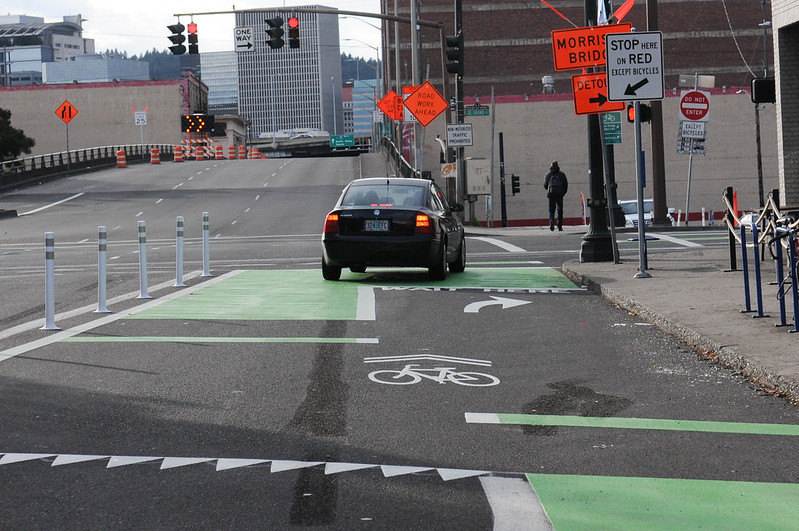
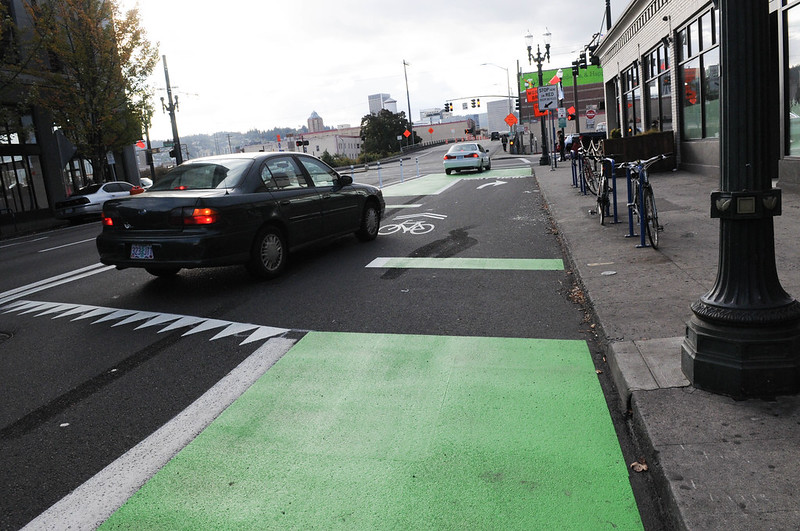
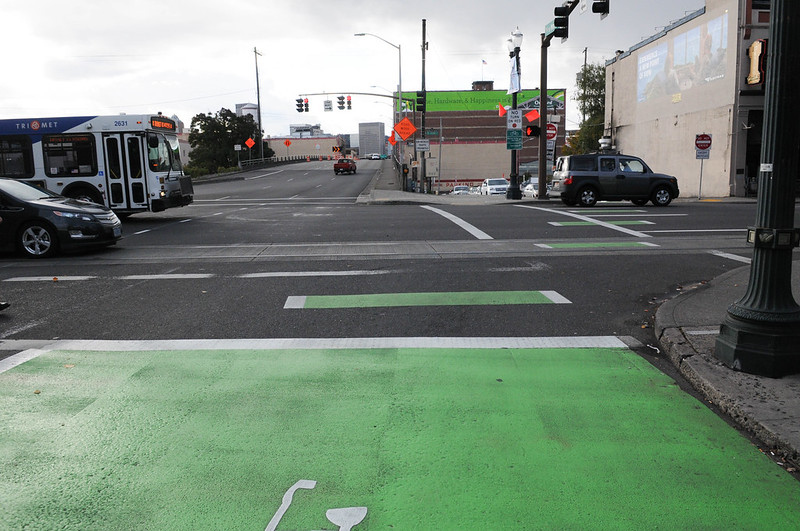
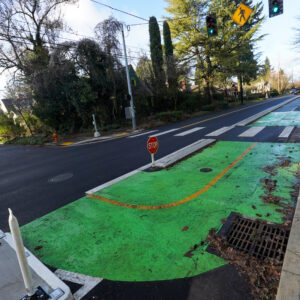
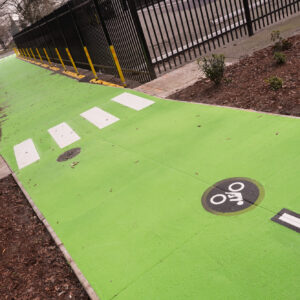
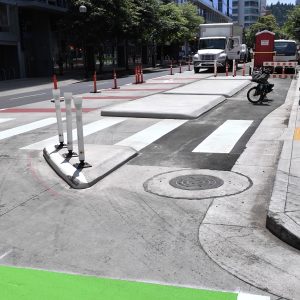

Thanks for reading.
BikePortland has served this community with independent community journalism since 2005. We rely on subscriptions from readers like you to survive. Your financial support is vital in keeping this valuable resource alive and well.
Please subscribe today to strengthen and expand our work.
I’ll never understand why we continue to deploy esoteric intersection designs that will deter new riders. I like the lane generally, but that Grand segment is not good. Mixing bikes and cars in the same space is a non-starter for the very people a protected bike lane is supposed to entice.
And what’s even more frustrating is we already have the solution at NE Broadway and Vancouver: a dedicated right turn phase and otherwise cars are not allowed to turn and bikes can proceed forward without issue. We need to remove the conflict altogether.
Jake, nice use of the word “esoteric”!!
I like the word/use here too.
Funny aside: In German the word Esoterik actually means New Age. Weird, I know.
Every time PBOT works on bike infrastructure I imagine a conversation like this one:
“Well…nothing’s worked yet. Why don’t we try something new?”
“Standardizing on proven international best practices?”
“No, something *new.* We’re smarter than any of those European folk, because we can put in bike infrastructure that doesn’t inconvenience the important people — car drivers! Smithers, invent a completely new design for this intersection!”
— 6 months pass —
“Well…nothing’s worked yet. Why don’t we try something new?”
I generally agree but would like to note that right turns here are more check more tricky because drivers can turn right despite a red light, which is not standard practice in Europe. As a result drivers here who want to turn right lurch into intersections while turning their head left to check for traffic. Thereby, they tend to ignore bicyclists to their right, bike painting in the ground and signs in front of them stating “No turns on right”, if these exist. I observe that almost daily on my way to OHSU’s tram from the SW waterfront, where I sometimes have to stand right in front of the driver and point at the “No turn” sign for them to see it.
So I challenge everyone here to propose a solution to these types of intersections that actually works well. Different phases for bikes and cars might work well in Europe, but only because car drivers there do not assume that they can turn right while having a red light. That is why the Broadway / Vancouver intersection gives me goosebumps, I never feel that I can trust the drivers to respect my green phase.
The intersection is probably okay with some minor additions:
1. Remove the bike box and extend the bike lane to the corner. You can do this because bikes aren’t supposed to be on the Morrison Bridge, so your two legal options are to turn right onto Grand or to cross to the MUP.
2. Segregated bike signal phase. Put a bike signal, car right turn signal, and a huge LED “no right turn on red” sign on the corner. The LED sign is active only when the bike signal is green. Those that turn right get less time to do so than thru traffic when Morrison has the green.
Only mitigating factor is what appears to be a bus stop right there at the turn. That might need to be relocated for this to work. The result isn’t Dutch but at least it would seem safer.
This would be a huge cost, and another 2 years of traffic study, to install those signs….
Morrison has the following mouths to feed: bus and bus stops, bikes, parking, car travel, and loading zone access. City successfully put in a design that works well for none of these, works poorly for all. But, kudos for at least appearing to be more weighted to bike specific infra. I am curious to see how the delivery drivers will deal with this new set up – double/double park outside the parked cars or park in the bike lanes; or deliver between 6 – 9 AM and park in the car lane and unload into the bike lane.
From my post you commented on: “Different phases for bikes and cars might work well in Europe, but only because car drivers there do not assume that they can turn right while having a red light.” Looks like you proposed just that; it seems like a good idea but drivers don’t pay attention to the “No turn” sign, even with flashing red light because they are focused on making a right turn.
“Well…nothing’s worked yet. Why don’t we try something new?”
What I’d like to know (hello PBOT, why not weigh in here with a reply? we know you read bikeportland) is whether these novel solutions that tend to baffle those of us who ride through these locations were run by anyone, tested in any of the familiar, conventional ways? What is the process by which such treatments get approved and installed? And I’m not intending to single out PBOT, the County, after all, did their rumble strip on the Hawthorne bridge bust stop ramp without *any* consultation….
I pity the poor sod that has to sift through this place as part of their job. My GF thinks I totally waste my time here and hopes I’ll get banned.
But the question of how these solutions are arrived at is well put. When solutions confuse those who are far more attentive to infrastructure than normal people, you gotta wonder.
Surely they wouldn’t be expected to comment 20 or 30 times per post….
15 would suffice 🙂
Totally agreed. I encountered the Grand portion of the lane for the first time while a passenger in a motor vehicle. The driver (also a cyclist) and I both had more than a moment’s confusion about what exactly we were supposed to do. I can’t imagine how drivers who don’t ride (and have limited patience for bike infrastructure generally) will react.
Wow, that Merge/Bike Box atrocity is bad.
Bad for cyclists to try and quickly merge left, bad for cars to try and move right in what is obviously to small of a space. From just looking at I would say I’m not a fan as well. Would rather bicycles merge into auto lane much earlier or cross it completely into a bike lane left of the right turn lane back at even 7th with a bike priority signal.
Other option would be to just do a standard bike box that makes its “L” from the right rather than from the left as this one does. If right hooks are a real danger here we need to make it standard for there to be different bike/ped and vehicles signals so that right turning vehicles have a red when the bike signal is on and vice versa. If faster / more confident cyclists don’t want to wait while cars turn right they could merge into the auto lane and continue straight through with auto traffic. OR just eliminate the right turn altogether onto grand all together if this is such a critical bike route over the Morrison.
Overall this is again another point in which design of infrastructure for bikes is scaled down because “oh, bikes are smaller” when the reality is bikes need spaces and turning radii much more similar to that of autos.
Add to the fact the bikes are pretty much making half a right turn as it is at this intersection to continue on the bike route… do they really need to be left of the cars to do this?
Regarding Bus Lane / Parking and sightlines I would honestly be a bigger fan of having the bike lane outside of the parking / bus lane. Eliminates need for bus stop islands, improves visibility of cyclists for right turning and cross traffic. Also moves bikes out of the Gutter. Added conflict is parking access turning off peak hours and riding to the left of the bus… if this is concern then I agree Bus Islands and restricting parking approaching cross streets.
This new buffered bike lane is going to be temporary. After the buildings on those blocks get the wrecking ball treatment, this new bike lane will make a nice 3-year staging area for construction vehicles, and then be turned into an Uber/Lyft taxi stand after that. Enjoy it while you can – I guess it should be sponsored by River City Bikes, as it seems like they drew a green carpet to their door.
I concur with the bike box comments…very likely needs to be rethought after observations…
And I am concerned that:
1) the installation of wands and other bike thermo so late in the season (cold pavement and damp surfaces) may adversely shorten their lifespan in the field…this is compounded by the fact that bikeways are often placed in high conflict areas with motorized vehicle movements vs. wands placed for strictly motorized vehicle projects (parking areas etc.); and
2) the public outreach/ education flyer for ‘parkers’ needs to be revised with a better “NO” ( red”X”) photo as its a bit confusing in its message…is the red x communicating to parking enforcement to not enforce or park in the travel lane?!
Totally agree with the flyer. It took me a little bit to understand the meaning, and a non-bicyclist will be much more confused. Has no one reviewed these at PBOT? Seems obvious to me.
I think these photos of cars waiting in front of the “wait here” line settles the debate about whether or not spending too much time in automobiles lowers your IQ.
What debate? It’s a fact.
It is not a lack of IQ, they just know they can do it.
As stated in Repoman, circa 1984:
Miller: The more you drive, the less intelligent you are.
We need someone on City Council, with PBOT under their wing, who is as passionate about bicycle and pedestrian infrastructure as Chloe Eudaly is about housing justice. Until then we’re likely to continue getting stuck with inelegant, unsafe street designs like this crossing of Grand/MLK.
Am I the only one who feels like it’s time to demand Leah Treat’s resignation? Granted, she has never been given the necessary political backing to push for deep multi-modal transportation reform (the kind of support that Sadik-Khan got from Bloomberg in NYC), but she has quietly presided over the ongoing stagnation at PBOT for years now with barely a peep, even vocally supporting the I-5 Rose Quarter freeway expansion against all the counter-evidence. It’s a shame because there are so many young planners and designers inside PBOT looking to make change — but they need political and bureaucratic support, too.
Chloe’s predecessor was probably the best safe streets advocate we’ve had on the city council in a long time. I was rather upset when she won the election.
Novick and his ally Wheeler presided over the gutting of active transportation funding. We are where we are now (a decline in bike mode share for two years in a row) in large measure due to his and Wheeler’s moral cowardice.
do you mean Hales?
Bring back Adams? He seemed to have the vision and creativity to work outside the lines in order to get funding for the safe streets plans that he had. All the momentum has been dissipated after Hales and now Wheeler doing little to reverse it.
I’d be tempted to just take the lane and head straight across the bridge with vehicular traffic versus being 2nd class and going through that maze you’ve described. I’m assuming it would be legal?
On most bridges it would be legal. On the Morrison I’m not sure, as part of the bridge might be considered an extension of the adjoining freeway ramp. And due to those ramps it would be a lot more dangerous than taking the lane on some other bridges.
Given that you have to cross an I-5 onramp and offramp, that sounds pretty unpleasant to me.
“Speed limit” is 25 on the bridge… [cough]
I think his comment was a joke. If you drive the bridge, you know that the typical speed is already 40-45mph.
I have done just this many years ago. That off ramp from I-5 is a beast that I can not recommend facing down. It’s doable with determination, good timing, and a bit of luck, but no, I do not recommend it.
I think I did it once years ago too, westbound. And have never ridden it since, for good reason.
“I get the idea PBOT had, but the markings are confusing. Perhaps we’ll all get used to them, but it would be nice if they were more consistent all over town….
Making matters worse, only a minority of auto users seemed to know how to position themselves without encroaching on the bikeway….”
This is exactly what I’d expect with this design and it’s not going to get better in the dark and the rain. Expecting motorists or cyclists to be looking for deteriorating paint paint on the ground and instructions in small letters in a highly dynamic environment for guidance is a recipe for failure.
I haven’t ridden this yet, but my guess is that there’s a good chance I’ll take the lane for the simple reason that the potential for conflict is much less.
One of PBOT’s most-used tools for traffic management is confusion. I guess these temporary little posters are some sort of mitigation for this, but long term, confusion is king. Example – the green zebra stripes. I have heard many people ask whether they are obligated to stop at green stripes for bikes. And, I expect there’s a 10-year study plan requirement before any permanent signage can be applied to a street in this town (5 years to get any paint on the pavement).
But, in PBOT’s defense, confusion as a traffic calming device is one of the preferred tools they have to implement new design ideas, given the state’s control of actual traffic laws (of course, enforcement of existing laws is on the city, and we all know how often that gets done).
Yes, my memory is that the two-way bicycle lane and do not enter except has been there since at least early this year. Google sattelite view doesn’t show it yet, however.
If I was riding without knowing my route ahead of time and was wanting to get across the river, I would have no idea that I could use the Morrison Bridge.
It’s a road.
Unless there is a sign saying nonmotorized traffic is prohibited, you can go. Whether you would want to is another matter. I haven’t ridden it myself for a long time. Looking at the pics now, I’m not sure why I did.
Fortunately, neither Hawthorne nor Burnside are that far out of the way and are probably better distance wise for most destinations.
Oops — didn’t see that when I rode it. To be honest, I’m watching vehicles and am probably totally oblivious to signs when I’m in fast traffic with no shoulder.
My recollection of the experience is that it wasn’t much worse than St. John’s bridge (which has bike sharrows) when the traffic is moving full bore. Speed limit might be 35 there, but it seems like it sometimes moves closer to 50 — not fun when traffic is heavy enough to be “busy” but not heavy enough to slow it down.
Yet there’s a sidewalk right there. Is that for motorized pedestrians?
I got stopped by some tourists on bikes at Grand and Belmont. They were asking how to get across the Morrison Bridge on a bike. I have done it a dozen times, so I tried to explain. Then I got out my phone and tried to show the route. They were baffled, and no wonder! Not only is the bike infrastructure on the Morrison Bridge nearly inaccessible from anywhere useful, the infrastructure itself is pathetically undersized. If the City ever created safe connections for ped or bikes to the Morrison, that skinny sidewalk would be so inadequate. The only making the shared, 2-way bike/ped path on the Morrison useable today is that no one can find and it doesn’t connect to anything.
I think the bike stuff on Morrison and Belmont are great between Grand and 12th, and I sincerely hope they extend them farther east. I think their limited investment west of Grand is a complete waste of money- it is impossible to follow, the route sucks, the infrastructure sucks and teh bridge itself sucks. Until they commit to something real on the bridge, I think we would all be better served if they removed everything west of Grand.
We will have to see what it looks like in 2 weeks when the reveal the new treatment on the bridge.
The intersection with Grand is horrible. How many of those drivers made an illegal right turn on red?
Another problem I see in the first photo. There are already leaves piling up against the curb. What is the city’s plan to sweep these lanes? Oh, that’s right, there isn’t one.
I’ll be taking the lane. When a frustrated motorist assaults me I will inlcude the city in my civil suit.
I hope they traffic cameras here and at Couch and start issuing tickets for right on red. Also, the City needs to make Lloyd at MLK no right on red.
Well, jeez, look at the glut of signs in this photo:
https://www.flickr.com/photos/bikeportland/36986932683/in/dateposted-public/
It took me a while to even spot the ‘No Turn On Red’ sign. It’s sitting to the right of the intersection on a post, rather than over the intersection next to the appropriate signal head, per MUTC guidelines.
Overal, a very nice improvement between Grand and 12th. I hope they keep 6th one way southbound between Morrison and Belmont for motorized vehicles and 2-way for bikes. 6th is the best n/s route through the CEID by far, and the construction here has been an excellent diverter. We need a few more diverters and a few stop signs turned and 6th would be a great greenway.
Overall, a great improvement to the streetscape. I work in the area and definitely appreciate the safer pedestrian crossings.
On foot, I observed lots of vehicles moving through the Morrison/Grand right-turn area … and they inevitably stayed left, cruising over the green paint, then turning right. Strikes me as a bit of a design oversight to think that cars and bikes are going to switch left/right positioning in this short stretch before the intersection.
Since cyclists are generally going near-straight, not turning right, it may make better sense to switch the “Wait Here” to the left side … and keep the green bike lane green flowing straight and continuous. This would also be consistent with most other bike boxes in the city.
I do like that there seems to be plenty of lateral width at this mixing zone. I appreciate that PBOT is trying to minimize right hooks, but I don’t think this design achieves that. Would like to see more clarity that cyclists going ‘straight’ have ROW, as per usual rules of the road.
Personally, for my own paranoid safety reasons, I would pace myself to only approach this intersection on a red light.
With the exception of a City car parking in the new bike lane between 11th and 12th today – with no occupant – I expect that parking in the bike lane will not be a big problem due to the numerous bollards. If you do see it, call it in: 823-5195 [PDX truly engages in only complaint-driven enforcement].
+1 liking the high frequency of bollards.
This is horrible.
Portland bicycle riders get hit almost exclusively at intersections. Hiding those intersections behind a row of parked cars strikes me as nothing but pure idiocy. All because some unholy alliance has been formed between a) people who want to trick new riders onto the streets with a false sense of safety and b) people who want to get bikes out of the way of cars.
Hear, hear! I notice that even JM was a bit down on this, and a more robust fan of so-called protected bike lanes is hard to find. Just looking at the pictures I got nervous that I was about to be right-hooked from some small car hiding behind a parked van.
If this is the direction PBoT is heading, PDX can look forward to another nine years of cycling mode stagnation, or worse.
ORS 811.550(17)
Can we just start enforcing the law? It would be so much safer and more convenient for all road users.
My very Portland Tuesday complete with shameless plugs: Need a conference table. Stumbled across Urban Timberworks (wow, cyclist owner Leland hooked me up. Sweet!). Hit Showers Pass (’nuff said), Bunk Sandwiches (ditto). Pedaled west on Morrison. Whoa! Approaching Grand there’s… shark teeth and green paint everywhere. Felt a bit chuffed since someone was thinking of cyclists. Headed west across the cross-bike when… dang! somebody right hooks me. I narrowly avoid. Didn’t have a chance to diagnose, but it wasn’t a good first go.
You stay to the left of right-turning motorists if you are going straighter than them, how hard is that to understand? Every one of Jonathan’s pictures shows enough room to pass right-turning motorists on the left. The protection offered by the green paint is entirely imaginary.
The basic issue here is that this intersection should not be set up to cycle straight through. As John points out, it’s illegal to ride on the bridge itself. Grand itself is a particularly sucky road to ride with the tracks on the right and uphill grade.
Solution, absent major changes to the Morrison/Grand intersection? No bike box, bikes cross as peds with beg button. There is absolutely no reason not to walk this because once you get to the other side, you only can ride literally a few seconds before you have to stop anyway.
Pulling in front of turning vehicles with a light in a busy intersection is absolutely insаne — the only safe way to do this is to get in the flow on the outside. This is true even for the very few cyclists who intend to continue along Grand.
Second Class?
Well, now that you mention it, maybe Third Class….
There’s nothing second class. It’s common sense.
Anyone who drove on the right side of a bunch of cars turning right so he could continue straight would be correctly and universally regarded as a total imbесile. Pulling the same maneuver with no protection whatsoever is even more idiоtic.
For all the fear people have of the easiest traffic conditions, I find it absolutely astounding what some of you advocate.
“I find it absolutely astounding what some of you advocate.”
You do this here with some frequency: You make the jump from an objection to a categorical or internalized state to advocacy of crazy behaviors. I’m sure some here do advocate for scary or irresponsible acts, but for the most part I don’t think we do, but you nevertheless (mis-)hear us doing this, for your own reasons that remain inscrutable – at least to me.
Please tell me why it’s important to ride straight ahead in front of turning traffic, particularly if they must stop a few seconds later.
A crossing like that calls for a protected signal. Given the number of drivers, the best thing to do is close off the bike lane towards the end, and just have bikes cross as peds. It’s safe and it doesn’t cost any time.
Those comfortable with traffic can cross in the lane. Those uncomfortable with traffic have no business pulling a maneuver that requires considerably better timing and skill if the driver doesn’t see them or yield for whatever reason.
“Please tell me why it’s important to ride straight ahead in front of turning traffic”
I wasn’t speaking narrowly to that, or suggesting that—without changing lots of other present modal-specific prohibitions—that anyone should do this. My point was a much larger one, that it is precisely all the inherited prohibitions on bicyclist travel at this location, and the mediocre ‘solutions’ you are proposing that indicate the lower-class treatment of those of us who bike as a class.
There is no doubt that there is certainly a modal bias in how the transportation network is generally set up, nor is there any doubt that inherited prohibitions require extra measures to rectify.
In the case at hand, the amount of changes necessary to overcome this bias are extreme enough (both the Morrison Bridge and Grand need major changes to be significantly safer) that I strongly believe such resources should be expended elsewhere where there are more cyclists who face fewer alternatives. Since I have bridge areas on the brain, I would suggest St. John’s as this is heavily used and widely known to be dangerous.
I’ve been watching/walking/riding this intersection for close to 7 years now, during mid-morning traffic through early evening traffic (I work nearby). I’ve had a few close calls over the years, but I have to say this new traffic pattern is HORRIBLE. Just yesterday I had the closest of all close calls, due to the confusion of the merging of bike/auto traffic lanes for the right turn. As I approached SE Grand from Morrison, I checked over my shoulder for any middle lane cars signalling to turn right (as they tend to make right-hand turns from the middle, “Straight Only”, lane onto SE Grand. There was one SUV in that lane just behind me, no signal blinking. We both had the green light. I intended on riding through the intersection, in the bike lane, to get down to MLK. As I crossed over the first light-rail track on Grand, I see the SUV in my peripheral, turning right onto Grand – RIGHT IN FRONT OF ME. A very impressive two-wheeled skid/drift later (along with an echoing yell of some colorful wordage) I navigated around the back-end of the car. I then get the “I’m awefully sorry” wave from the driver.
I can only imagine how this may have played out if it was dumping rain and it was a new commuter maneuvering for their life.